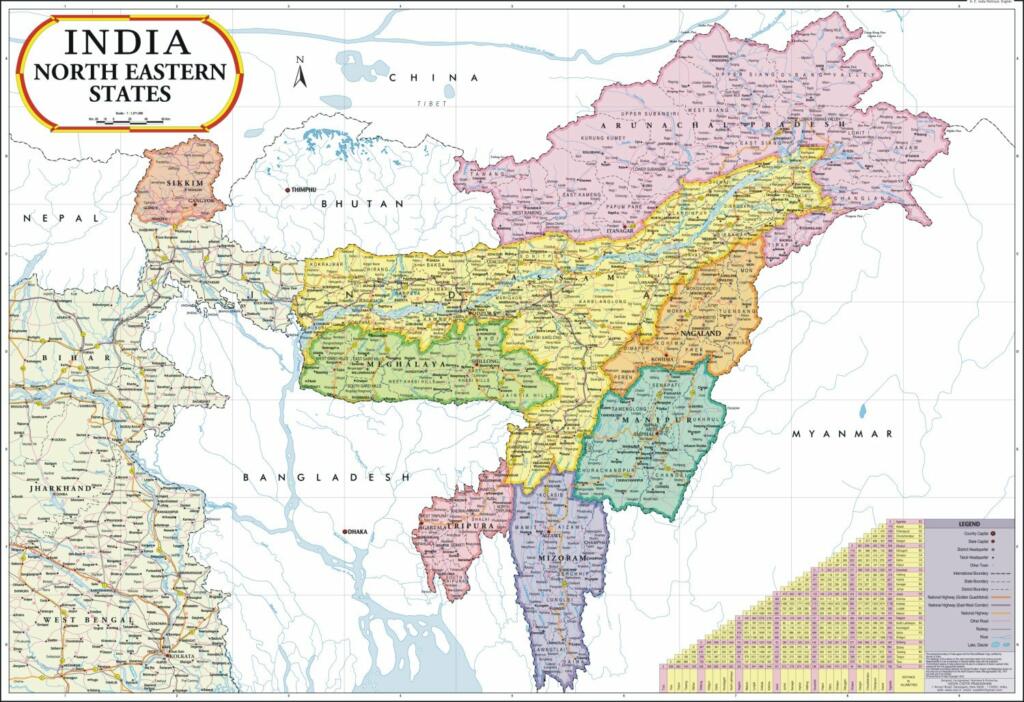Five Assam Police personnel were killed while fifty suffered injuries after violent clashes broke out between Assam Police and Mizoram Police on Monday. The long-standing border dispute finds its root in the colonial past and to this date continues to haunt the integrity of the country in the Northeast region.
It all began in the British era when Mizoram used to be a district of Assam. The state of Mizoram, as we know it today used to be called Lushai Hills. Essentially, the North East comprised the states of Assam, Manipur and Tripura, with the states of Meghalaya, Nagaland and Mizoram, all being carved out of Greater Assam during the later years.
In 1875, a notification was issued that differentiated Lushai Hills from the plains of Cachar Hills (another district in present-day Assam). Similarly, in 1933, another notification was issued that demarcated a boundary between Lushai Hills and Manipur. This particular notification indicated that the Manipur border began from the tripoint of Lushai Hills, Assam’s Cachar district and Manipur.
Mizoram, which became a Union Territory in 1972 and a full state in 1987 continues to claim that the boundary should be demarcated on the basis of the 1875 notification, which is derived from the Bengal Eastern Frontier Regulation (BEFR) Act, 1873. It is significant to note that BEFR defined the Inner Line Regulations, better known as the Inner-Line Permit (ILP) system.
However, the Assam government follows the 1933 demarcation, and that is the point of conflict. Mizoram argues that the 1933 demarcation notification was issued without any consultation with the Mizo society.
Based on the 1873-regulation, Mizoram claims a 509-square-mile or about 1,318 sq km area of the inner-line reserve forest notified 148 years ago. Meanwhile, Assam is not willing to give up any of its territories.
The British hurriedly demarcated the regions without taking much cognisance of the on-ground reality of various tribal groups. The Congress government followed a similar destructive modus operandi as ethnic boundaries were not given due importance and the states crudely carved out of Assam.
Mizoram continues to assert its claim over the territory by stating that a sizeable population of ethnic Mizos reside in the Cachar Hills, suggesting that it is part of Mizoram. One of the other reasons why frequent clashes have occurred on the border is the presence of different ethnicities. Groups mainly clash to suppress the minority ethnic group. At times two ethnic tribal identities clash in order to dominate the region.
This issue has existed for decades and the previous governments did not make serious attempts to solve it. A few days ago, Home Minister Amit Shah visited the Northeast to meet with the Chief Ministers and Chief Secretaries of the states which are part of the North-Eastern Democratic Alliance (NEDA) and asked them to resolve the border issues.
The act by Mizoram Police was brutal and not acceptable under Indian law. Assam Chief Minister Himanta Biswa Sarma tweeted a video in which the Mizoram police were seen celebrating the death of Assam police personnel. “After killing 5 Assam police personnel and injuring many, this is how Mizoram police and goons are celebrating.- sad and horrific,” tweeted Sarma.
After killing 5 Assam police personnel and injuring many , this is how Mizoram police and goons are celebrating.- sad and horrific pic.twitter.com/fBwvGIOQWr
— Himanta Biswa Sarma (Modi Ka Parivar) (@himantabiswa) July 26, 2021
Before the events of Monday, skirmishes had occurred last year as well. In October 2020, a scuffle had ensued in the conflicted territory after a group of people from the Mizoram side of the border torched some huts made by residents of Assam’s Lailapur village on a disputed portion of the border between the two states.
The Union Home Ministry must solve these issues in collaboration with both states by sitting them across the table. In the last seven years, the NDA government has built more infrastructure in the area and solved much more complex issues than Congress could do in seven decades and now it is high time the border disputes are resolved, once and for all.
